中国科技论文在线
http://www.paper.edu.cn
Zero-inflated Negative Binomial Model and its Application
in Car Insurance
Jiang Tingting, Huang Wei**
(College of Mathematics and Statistics of Chongqing University, Chongqing 401331)
Abstract: Under many circumstances, most car insurance data appears to be zero-inflated and their
risks are nonhomogeneous. These lead to general traditional claim frequency models lost their
prediction effect, so they are unsuitable to fit this kind of data. This paper is using the car insurance
data for GINB model, ZINB model and C-ZINB model to do empirical research, the results
demonstrate that the C-ZINB model can overcome the risk of homogeneity and zero inflation very well.
In addition, C-ZINB model has good simulation prediction effect.
Key words: Statistics;Negative Binomial Distribution;Zero-inflated Model;Car Insurance
5
10
15
0 Introduction
Relative to other financial industry, the insurance is a new type of financial industry. With the
expansion of the various risks, the insurance is gradually developing into a global industry in just a
few decades. Insurance usually can be divided into two categories: life insurance and non-life
insurance. Life insurance has developed for a long time and had a lot of historical data, so scholars
20
have already get much achievement. Although formation of non-life insurance is earlier than life
insurance, the study of non-life insurance is far later than life insurance. Therefore, the
development of non-life insurance is slow and the historical data is less. Moreover, different
insurance object obey different distribution. Even if we can determine what distribution the
insurance object obeys, its parameter estimation is also very difficult. Sometimes, the loss
25
distribution of same risk also varies with time and environment. Because of the complexity of the
loss factors, the scholars have difficulties making non-life insurance pricing.
Generally speaking, non-life insurance is property insurance. In property insurance, the
development of car insurance is most rapidly. With the development of economy, car becomes
people’s main traffic tool. The increasing of the number of car is creating condition for the
30
development of car insurance. The birth of third-party liability insurance and mandatory traffic
liability insurance is speeding up the development of car insurance too. Now, the proportion of car
insurance in property insurance is the largest. The operating conditions of car insurance directly
affect the economic benefits of property insurance company.
Because of the rapid development of car insurance, how to stable the premiums and at the same
35
time reduce the loss ratios of car insurance is becoming the main problem. So the study of claim
number of car insurance is particularly important. Secondly, because of deductible, no claims
discount, personal factors and some other reasons, make insurant may not claim to the insurance
company after the traffic accident. This lead to zero probability increases means spearing zero
inflation. Therefore, how to solve the zero inflation becomes the major problem to actuaries.
40
This paper is modeling zero-inflated model with negative binomial distribution, and discussing
the application of zero-inflated model in car insurance combined with the practical experience
data.
Brief author introduction:Jiang Tingting(1989-), female, Master, Main research: Statistical Methods and
Application
Correspondance author: Huang Wei(1968-), female, Associate Professor, Main research: Probability Statistics and
Applications, Financial Engineering and Application, Stochastic Analysis and Application. E-mail:
tan16.tt@163.com
- 1 -
�
中国科技论文在线
1 Negative Binomial Model
http://www.paper.edu.cn
Negative binomial distribution not only can be satisfactorily used for fitting the claims data, but
45
also has a very simple property that its variance is greater than its mean. So it is good for fitting
the actual data which is nonhomogeneous. Negative binomial distribution has been widely used in
risk management because of this simple property.
In early study, we generally assume that risk is homogeneous. The claim number
obey the
poisson distribution
. It means
in each risk is fixed and be a constant. But in practice, the
50
risk may not be homogeneity. Nonhomogeneous risk caused impossible be a constant.
Let
be the kind of risk’s random variable and
probability distribution is as follow:
. Then the
,
Assume that
, then the probability density function of
is:
55
Using the total probability formula, the probability distribution of the claim is given by:
So
obey the negative binomial distribution:
.
For
, let
,
.Then the form of negative binomial
60
distribution becomes
. The parameter means divergence parameter,
the higher the
, the more serious the risk of nonhomogeneous. And the probability density
function is transformed as follow:
(1)
Its mean and variance are:
65
Let
, then the negative binomial model
is
transformed
into
the generalized negative binomial model, namely GLNB model.
- 2 -
NPiNiiiNP1,2,,is,0,1,2!iiyiiiiiiPNyeyy,ii11iiife101!1111iiiiiiiiiiiyiiiiyiiPNyPNyfdeedyyyiN1,1iNNBiiiE22iiVark111,iikNNBkkkk1111111ikyiiiiiiiykkPNykkykiiEN1iiiVarNk01122expexp+iiiiippxxxx�
中国科技论文在线
http://www.paper.edu.cn
70
the zero-inflated model is established by the generalized negative binomial model.
means
kinds of factor which affect the claim frequency. In this paper,
2 Zero-inflated Negative Binomial Model
2.1 Zero-inflated Model
Zero-inflated model was first put forward by Johnson and Kotz[1]. They divide the source of
count data into two parts: The first part explains the cause of zero inflation, and the count data can
75
only be zero. The second part is subject to a discrete distribution, the count data can be zero or a
positive integer. It means the zero count process is a mixed probability distribution, the probability
of zero comes from two parts: structural zero and sample zero.
Let the random variable of claim frequency be
, structural zero be
,
then the zero-inflated model is:
80
(2)
Among it, the random variable
is subject to a discrete distribution. The mean and variance
of
are:
85
2.2 Zero-inflated Negative Binomial Model
Let the random variable
of formula (2) obey the negative binomial distribution which means
, then the zero-inflated model is transformed into zero-inflated negative
binomial model:
90
Its mean and variance are:
(3)
Under normal circumstances, structural zero be a constant, In order to ensure
, we
usually let:
95
(4)
- 3 -
12,,,iiipxxxixp1,,iYis01(1)(1)1,2iiiiiiiiiiPYyPKyy=0PYyPKyy=,,,iKiY(1)iiEYEK2()(1)()iiiVarYEKkEKiK111,iikKNBkk111111111(1)(1)1,21ikiiiikyiiiiiiiikPYyy=0kykkPYyy=kkyk,,,1iiEY21iiiVarYk01logln1ita�
中国科技论文在线
http://www.paper.edu.cn
Solution of this equation is
. Take it into formula (3), it is known as the ZINB
model:
(5)
Generally, we use the maximum likelihood estimation method to estimate ZINB model’s
100
parameters. Due to the logarithmic likelihood function of ZINB model is nonlinear, so it needs to
use the numerical iteration method.
The logarithmic likelihood function of ZINB model can be expressed as:
Using the logarithm likelihood function and numerical iteration method, the parameter estimation
105
can be determined.
2.3 C-ZINB model
As mentioned above, various factors influence zero probability. In practical problems, the
abnormal zero probability is generally not only caused by single factor, it also may be caused by a
number of factors. So it seems not very reasonable if assume
as a constant. Now, on the basis of
110
the ZINB model, transform formula (4) as follows:
Among it,
,
means
kinds of
factor which affect the zero probability. Then the formula (5) is transformed into the C-ZINB
model:
115
3 Empirical Research
3.1 Model Select Criteria
In this paper, we compare models’ fitting effect according to the following principles.
- 4 -
exp1expaa11111111111111,211ikaiiiaaikyiiiiiaiiiekPYyy=0eekykkPYyy=ekkyk,,,101101lnln1ln1ln1lnln!lnln1iiikaaiyyiiiiiiyrlLneekkrykyykykklogln1iiiiiitaz01122+ziiiimmzzz12,,,iiiimzzzzm11111111111111,211iiiiikziiizzikyiiiiiziiiekPYyy=0eekykkPYyy=ekkyk,,,�
中国科技论文在线
3.1.1
Akaike Information Criterion (AIC)
http://www.paper.edu.cn
120
Akaike information criterion is created by Japanese statistician Akaike[2]. It can eatimate the
complexity and superiority of model. The formula of AIC is as follow:
is the logarithmic likelihood function value of model,
is the number of parameters. Akaike
suggests that the best model has the smallest AIC value.
125
3.1.2
Bayesian Information Criterion (BIC)
Schwarz[3] created bayesian information criterion on the basis of AIC. BIC is established under
the bayesian formula, its formula is as follow:
is the logarithmic likelihood function value of model,
is the number of parameters.
is the
130
sample size. Like the AIC, the smaller the BIC value is, the beat the model is. But the difference is
that the BIC considers the effect of sample size.
3.1.3
Vuong Test
Vuong test can be used to estimate the goodness of fit between the non-nested models. Firstly
let:
135
means the sample’s predicted probability of the model. Then the Vuong test
statistics of model 1 relative to model 2 can be defined as:
In this formula,
,
, statistics
obeys normal distribution.
140
Vuong[4] have proved that, Model 1 is better than model 2 while
; Model 2 is better
than model 1 while
; but it cannot judge while
.
3.2 Data Description
In order to do research with car insurance, the data comes from “Generalized Linear Models for
Insurance Data” which is third party liability insurance of Australia. It contains 10303 samples.
145
The statistical description of claim frequency and the frequency distribution are as follow:
Tab. 1 Statistical description of the claim counts
Variable Name
Mean
Claim Counts
0.80
150
MAX
5
MIN
0
Std.
1.15
- 5 -
22AIClplp2lnBIClpnlpn12lniiiiiPYXmPYXjiiPYXijmnmVS11niimmn211nmiiSmmnV1.96V1.96V1.96V�
中国科技论文在线
http://www.paper.edu.cn
Tab. 2 Frequency of the claim counts
Claim Counts
Frequency
Frequency
Cumulative Frequency
0
1
2
3
4
5
6293
1279
1492
992
225
22
0.6108
0.1241
0.1448
0.0963
0.0219
0.0021
0.6108
0.7349
0.8797
0.9760
0.9979
1.0000
155
160
Fig. 1 Histogram of the claim frequency
It can be seen that the claim number of zero is bigger, the proportion of zero accounts for
62.08%. Using the traditional poisson distribution and negative binomial distribution to fit claim
165
frequency will lead the results appeared deviation. The fitting results of traditional poisson
distribution and negative binomial distribution are as follow:
- 6 -
�
中国科技论文在线
http://www.paper.edu.cn
170
Tab. 3 Fitting result with poisson and negative binomial distribution
Claim Counts
Original Frequency
Poisson
Negative Binomial
0
1
2
3
4
5
6293
1279
1492
992
225
22
4626
3704
1483
396
79
13
6194
2470
985
393
157
62
175
Fig. 2 Contrast of fitting results
In table 3, the fitting effect of poisson distribution is worse than negative binomial distribution.
180
It means the risk of data is nonhomogeneous. Then observe figure 2, we find that even the
negative binomial distribution cannot get satisfying fitting results. Now, we use generalized
negative binomial model and zero-inflated model to fit claim frequency.
According to the influence factors of car, this paper we select age, gender, marital status,
educational background, type of car, car use, driving area and insurance period as the research
185
objects. Assign the influence factors and the statistical description of them are as follow:
- 7 -
�
中国科技论文在线
http://www.paper.edu.cn
190
Tab. 4 Variable assignment of influencing factors
Influence Factors
Variable Name
Age
Gender
Marital Status
Age
Gender
Married
Variable Assignment
Measurement Data
Male=1, Female=0
Single=1, Married=0
Educational Background
Education
Below High School=0, High school or above=1
Type of Car
Car Use
Driving Area
Insurance Period
Type
Use
Area
Years
Sports Car=1, Sedan=2, SUV=3,
Pickup=4, Panel Truck=5, Van=6
Private=1, Commercial=0
Suburb=1, Urban=0
Measurement Data
Tab. 5 Statistical description of the quantitative index
Variable Name
Age
Years
Mean
44.84
5.33
Std.
8.61
4.11
MAX
81
25
MIN
16
1
195
Tab. 6 Statistical description of the qualitative index
Variable
Name
Gender
Married
Education
Type
Use
Area
Frequency
Proportion(%)
Frequency
Proportion(%)
Classification of cases
Male(4758)
Single(4114)
Below High School(1511)
Sports Car(1179)
SUV(2883)
Panel Truck(853)
Private(6513)
Suburb(4631)
46.18
39.93
14.70
11.44
27.98
8.28
63.21
44.95
Female(5545)
Married(6189)
High school or above(8788)
Sedan(2694)
Pickup(1772)
Van(922)
Commercial(3790)
Urban(5672)
53.82
60.07
85.30
26.15
17.20
8.95
36.79
55.05
3.3 Model Simulation
According to the above information, we fit claim data with GLNB model, ZINB model and
C-ZINB model. We choose the eight factors as the negative binomial’s covariate in all models in
order to comprehensive analyze. And we choose the eight factors as the structural zero’s covariate
200
Too. The fitting results are as follow:
Tab. 7 Fitting results
Parameter
Estimation
Intercept
GLNB
Negative Binomial
0.1259
(0.1069)*
ZINB
Negative Binomial
0.5705
(0.0835)*
C-ZINB
Negative Binomial Structural Zero
0.3758
-0.9039
(0.0918)*
(0.1783)*
- 8 -
�
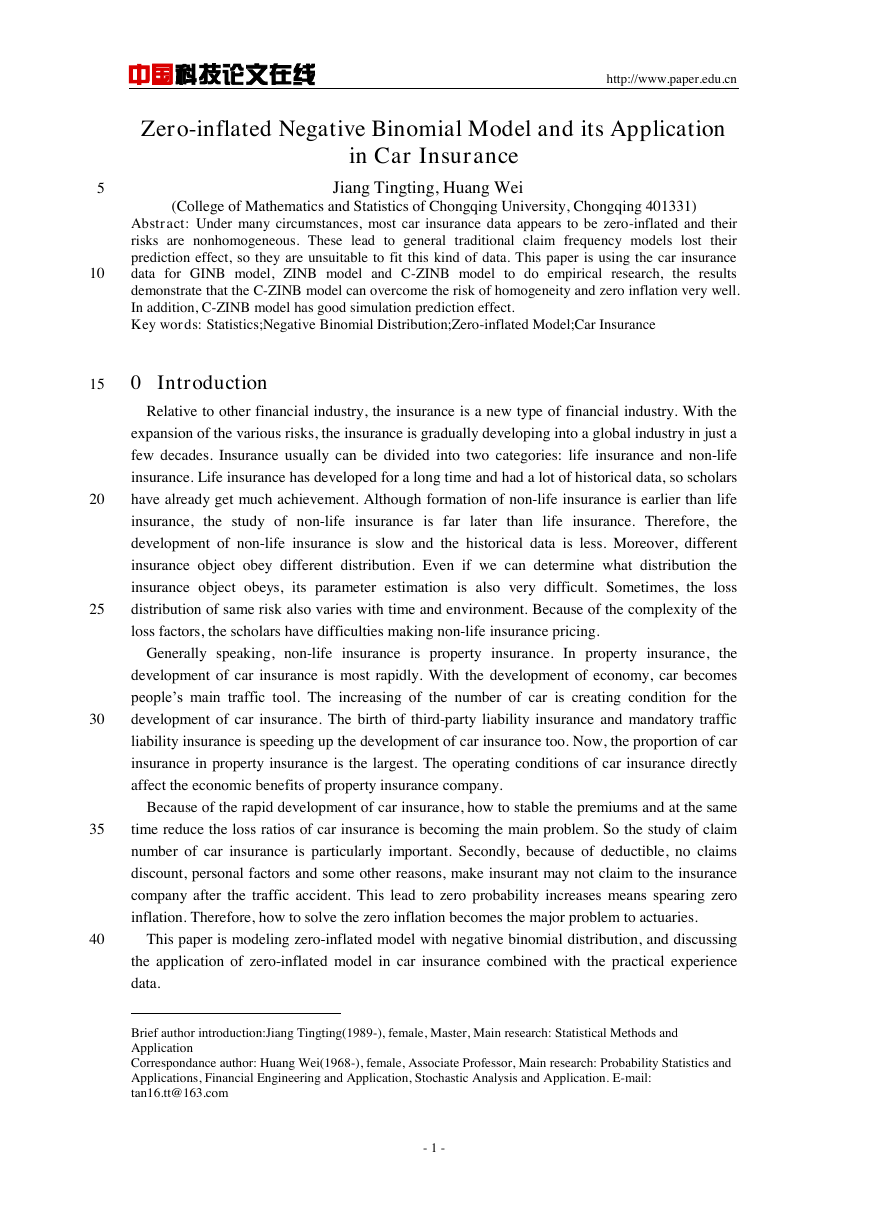
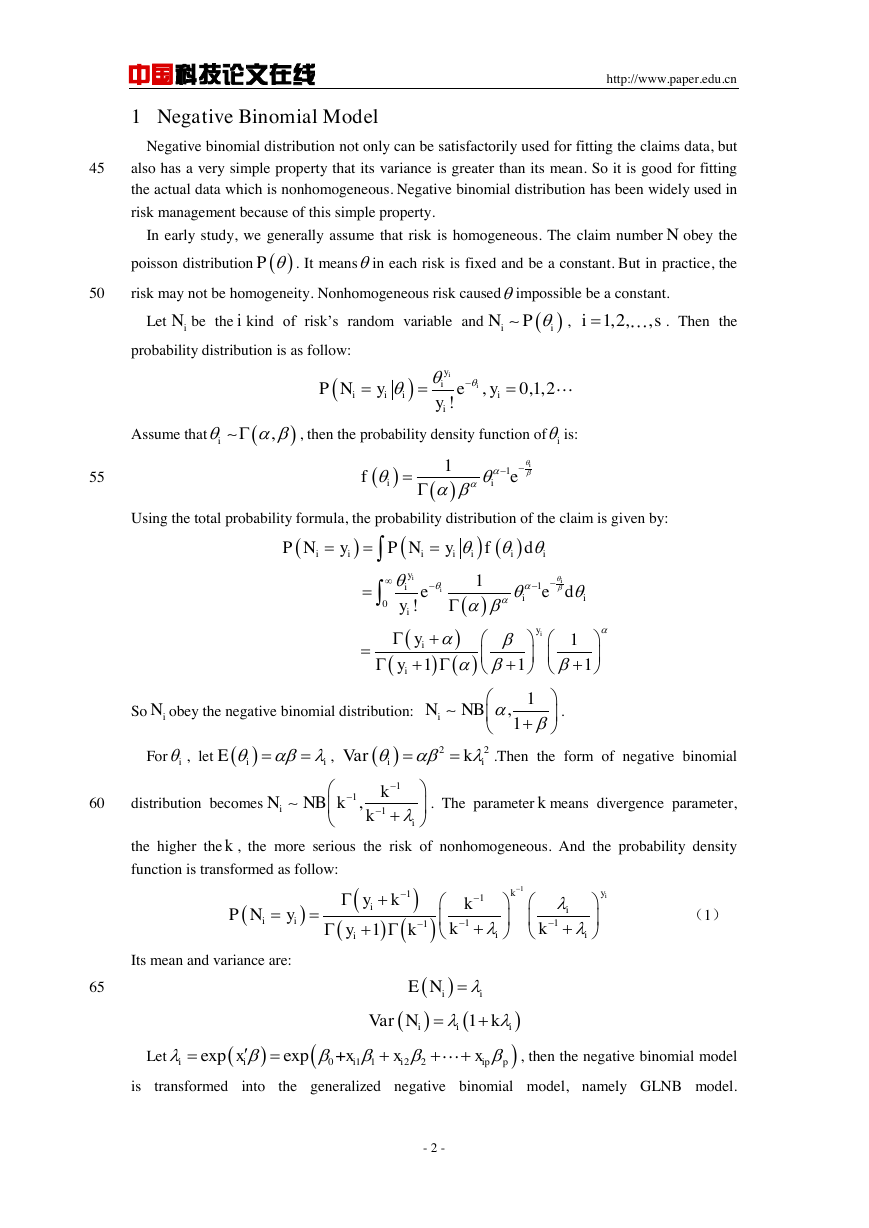
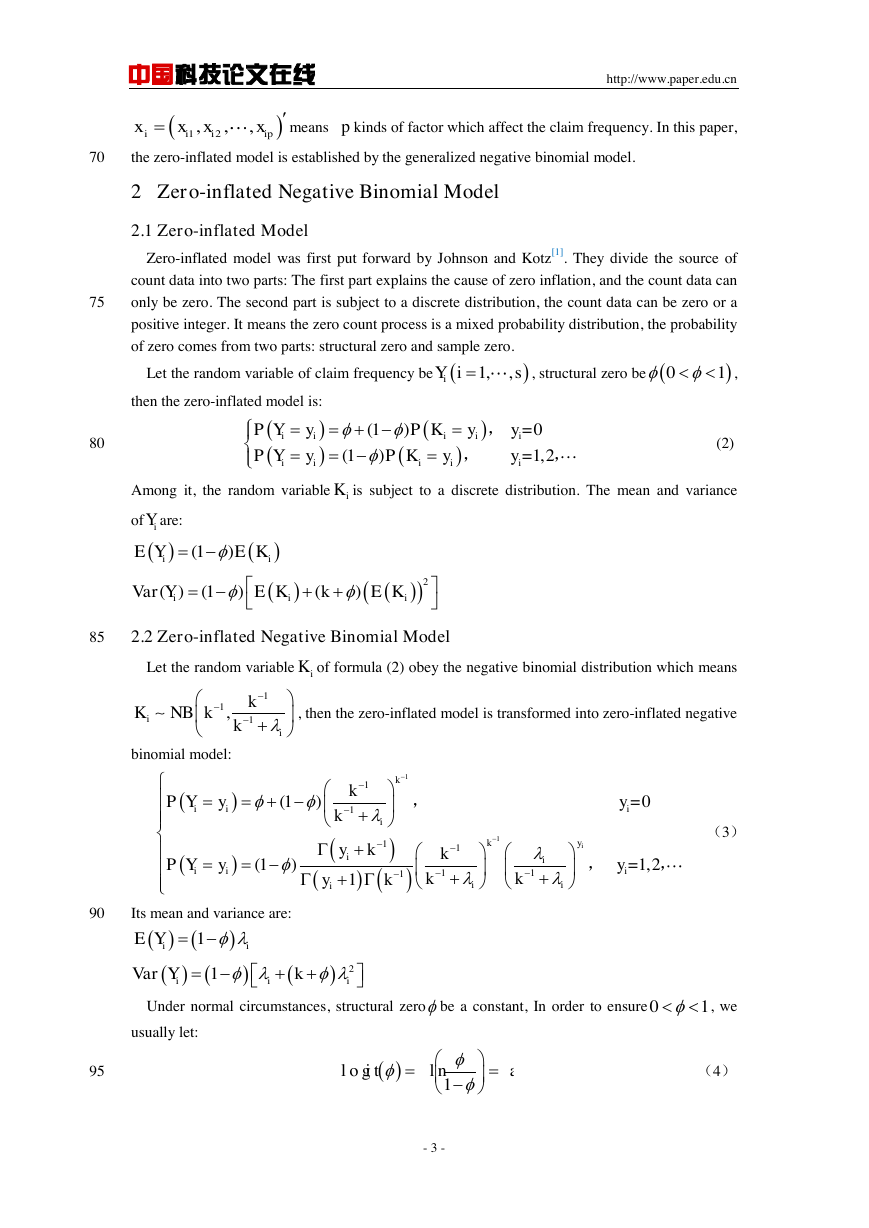
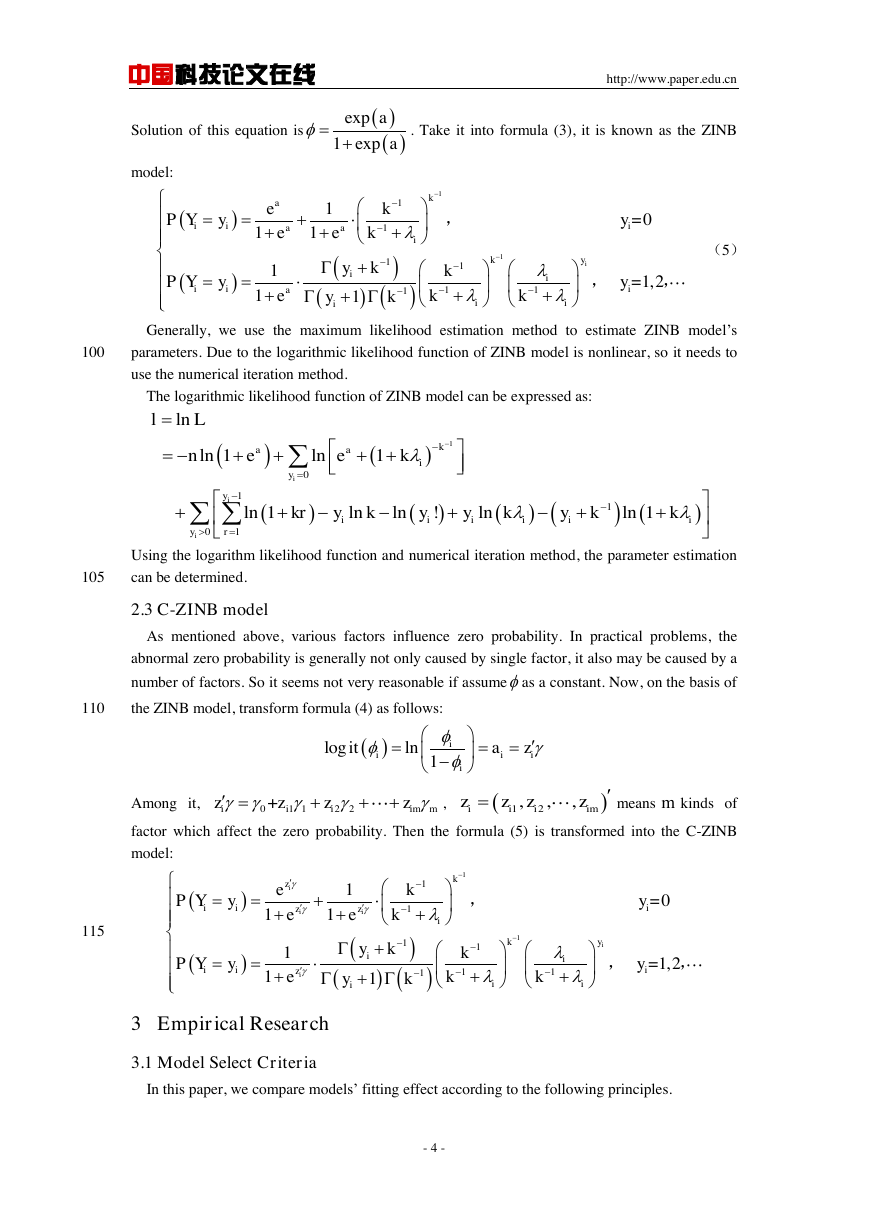
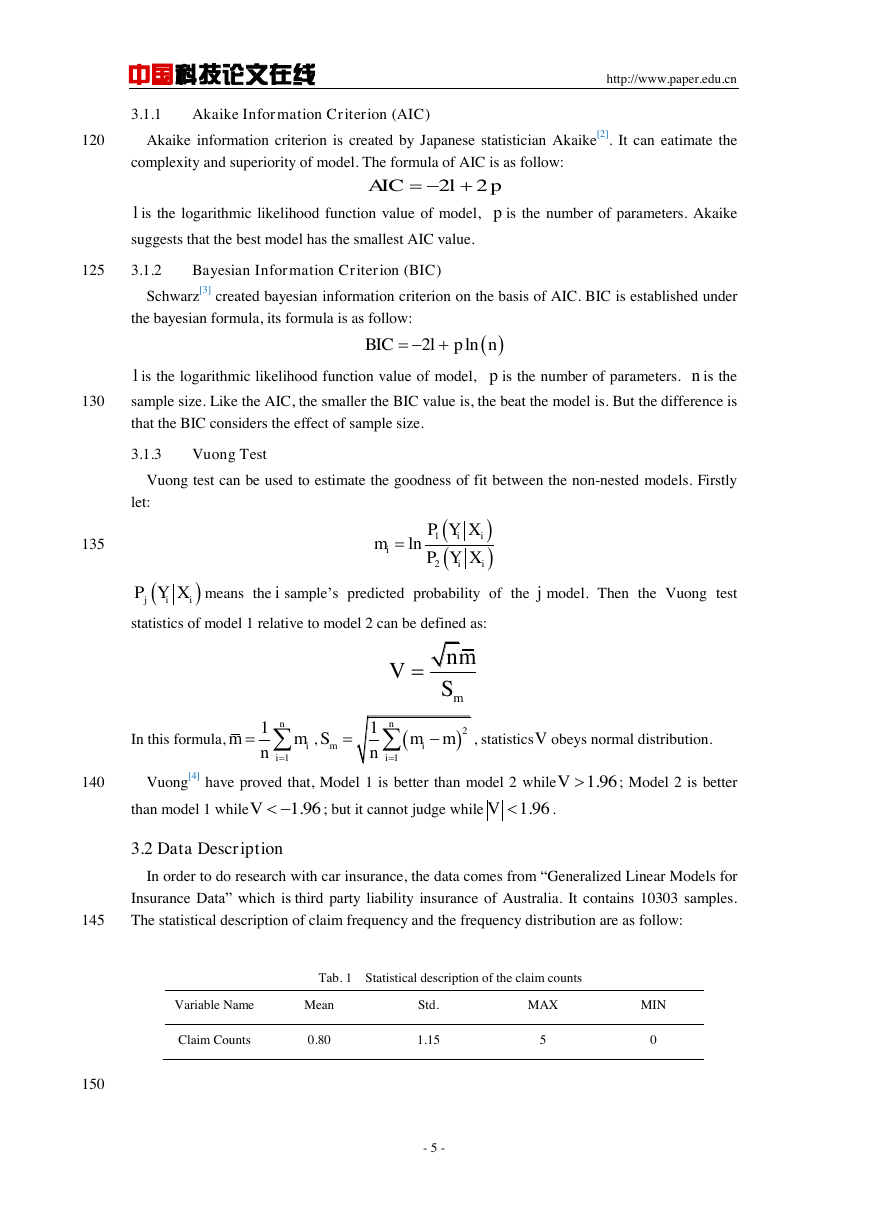
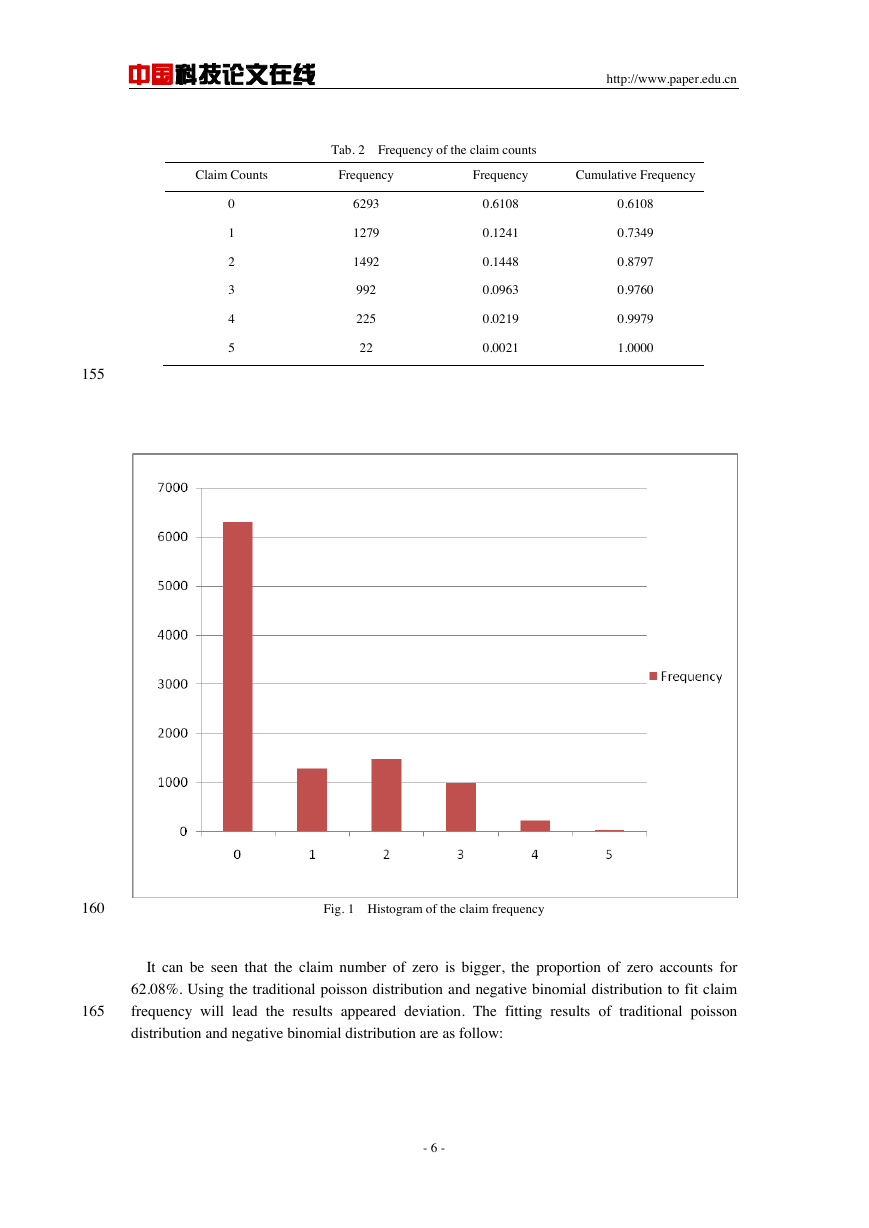

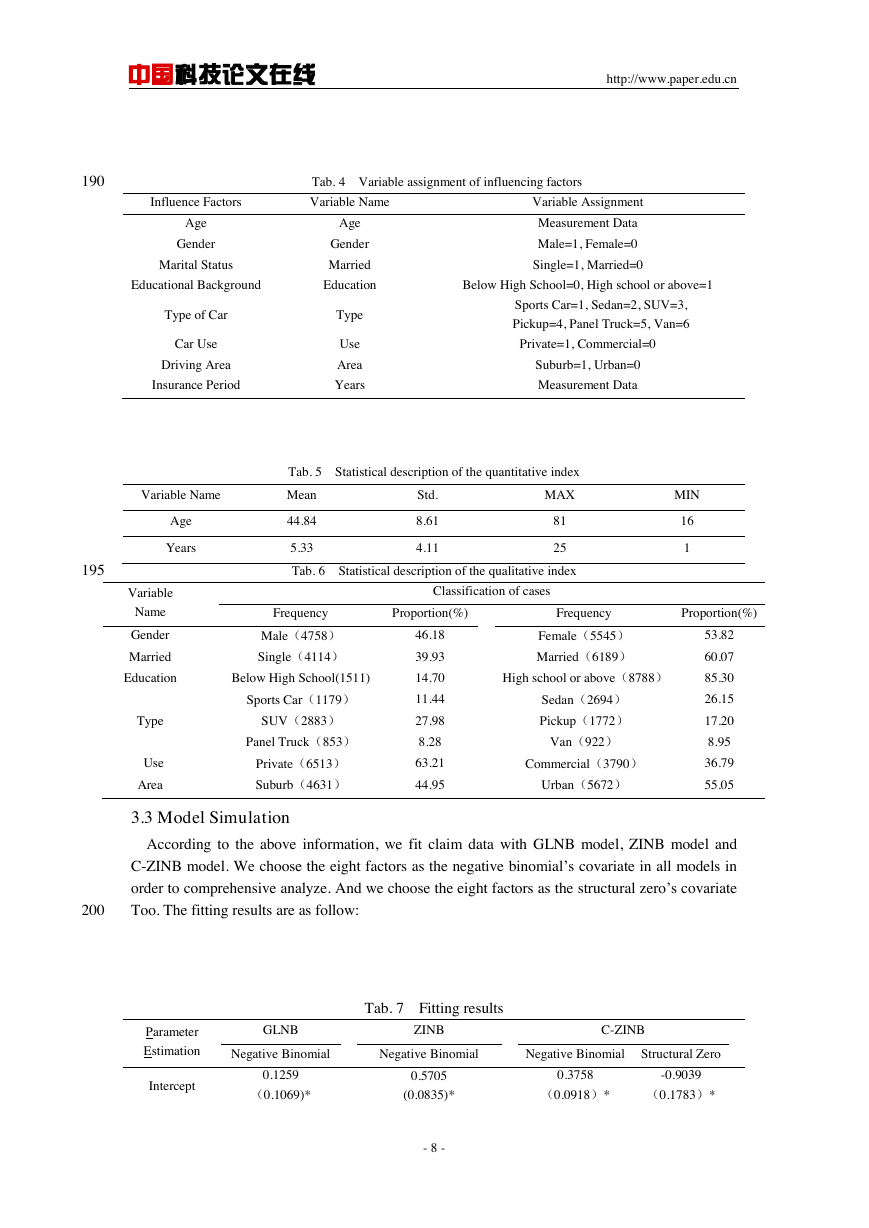








 2023年江西萍乡中考道德与法治真题及答案.doc
2023年江西萍乡中考道德与法治真题及答案.doc 2012年重庆南川中考生物真题及答案.doc
2012年重庆南川中考生物真题及答案.doc 2013年江西师范大学地理学综合及文艺理论基础考研真题.doc
2013年江西师范大学地理学综合及文艺理论基础考研真题.doc 2020年四川甘孜小升初语文真题及答案I卷.doc
2020年四川甘孜小升初语文真题及答案I卷.doc 2020年注册岩土工程师专业基础考试真题及答案.doc
2020年注册岩土工程师专业基础考试真题及答案.doc 2023-2024学年福建省厦门市九年级上学期数学月考试题及答案.doc
2023-2024学年福建省厦门市九年级上学期数学月考试题及答案.doc 2021-2022学年辽宁省沈阳市大东区九年级上学期语文期末试题及答案.doc
2021-2022学年辽宁省沈阳市大东区九年级上学期语文期末试题及答案.doc 2022-2023学年北京东城区初三第一学期物理期末试卷及答案.doc
2022-2023学年北京东城区初三第一学期物理期末试卷及答案.doc 2018上半年江西教师资格初中地理学科知识与教学能力真题及答案.doc
2018上半年江西教师资格初中地理学科知识与教学能力真题及答案.doc 2012年河北国家公务员申论考试真题及答案-省级.doc
2012年河北国家公务员申论考试真题及答案-省级.doc 2020-2021学年江苏省扬州市江都区邵樊片九年级上学期数学第一次质量检测试题及答案.doc
2020-2021学年江苏省扬州市江都区邵樊片九年级上学期数学第一次质量检测试题及答案.doc 2022下半年黑龙江教师资格证中学综合素质真题及答案.doc
2022下半年黑龙江教师资格证中学综合素质真题及答案.doc